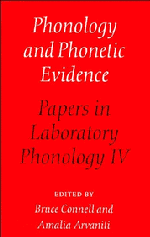Book contents
- Frontmatter
- Contents
- List of contributors
- Acknowledgments
- 1 Introduction
- I Features and Perception
- II Prosody
- III Articulatory Organization
- 15 Prosodic patterns in the coordination of vowel and consonant gestures
- 16 “Where” is timing? Comments on Smith
- 17 Asymmetrical prosodic effects on the laryngeal gesture in Korean
- 18 On a gestural account of lenis stop voicing in Korean: comments on Jun
- 19 A production and perceptual account of palatalization
- 20 An acoustic and electropalatographic study of lexical and postlexical palatalization in American English
- 21 What do we do when phonology is powerful enough to imitate phonetics? Comments on Zsiga
- 22 The influence of syntactic structure on [s] to [∫] assimilation
- 23 Assimilation as gestural overlap: comments on Hoist and Nolan
- 24 Orals, gutturals, and the jaw
- 25 The role of the jaw — active or passive? Comments on Lee
- 26 The phonetics and phonology of glottalized consonants in Lendu
- 27 Lendu consonants and the role of overlapping gestures in sound change: comments on Demolin
- Subject index
- Index of names
- Index of languages
24 - Orals, gutturals, and the jaw
Published online by Cambridge University Press: 03 May 2011
- Frontmatter
- Contents
- List of contributors
- Acknowledgments
- 1 Introduction
- I Features and Perception
- II Prosody
- III Articulatory Organization
- 15 Prosodic patterns in the coordination of vowel and consonant gestures
- 16 “Where” is timing? Comments on Smith
- 17 Asymmetrical prosodic effects on the laryngeal gesture in Korean
- 18 On a gestural account of lenis stop voicing in Korean: comments on Jun
- 19 A production and perceptual account of palatalization
- 20 An acoustic and electropalatographic study of lexical and postlexical palatalization in American English
- 21 What do we do when phonology is powerful enough to imitate phonetics? Comments on Zsiga
- 22 The influence of syntactic structure on [s] to [∫] assimilation
- 23 Assimilation as gestural overlap: comments on Hoist and Nolan
- 24 Orals, gutturals, and the jaw
- 25 The role of the jaw — active or passive? Comments on Lee
- 26 The phonetics and phonology of glottalized consonants in Lendu
- 27 Lendu consonants and the role of overlapping gestures in sound change: comments on Demolin
- Subject index
- Index of names
- Index of languages
Summary
Introduction
In Arabic, gutturals – uvular fricatives, pharyngeal fricatives and laryngeals –behave phonologically as a natural class in terms of some phonological phenomena such as co-occurrence restrictions and guttural lowering rules. The uvular stop /q/ does not pattern with gutturals with respect to these two phonological phenomena in Arabic. As shown in Figure 24.1a, gutturals have traditionally been specified as [-anterior, -hi] in the SPE system. The features [low] and [back] distinguish the uvulars, pharyngeals, and laryngeals from one another. However, this analysis suffers from phonetic unrealism. The features [low] and [back] in the SPE system are defined in terms of tongue body position. Yet laryngeals, which are said to be [+low], cannot involve the tongue at all, and pharyngeals, which are said to be [+low, +back], involve the tongue root instead of the tongue body.
The specification of gutturals also provides problems in feature geometries developed within non-linear models of phonology, such as those of Clements (1985) and Sagey (1986). First, if we translate the SPE feature specifications directly into these frameworks, the use of [anterior] for gutturals is impossible since in these feature geometry frameworks, it is used for specifications only of coronal consonants. The more crucial problem for these frameworks, especially for articulator-based feature geometry frameworks such as Sagey's (1986), is that gutturals do not share a single major articulator.
- Type
- Chapter
- Information
- Phonology and Phonetic EvidencePapers in Laboratory Phonology IV, pp. 343 - 360Publisher: Cambridge University PressPrint publication year: 1995
- 3
- Cited by



